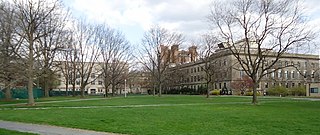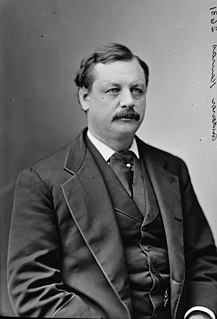This page is based on this
Wikipedia article Text is available under the
CC BY-SA 4.0 license; additional terms may apply.
Images, videos and audio are available under their respective licenses.

The Morrill Land-Grant Acts are United States statutes that allowed for the creation of land-grant colleges in U.S. states using the proceeds of federal land sales. The Morrill Act of 1862 was enacted during the American Civil War and the Morrill Act of 1890 expanded this model.

A land-grant university is an institution of higher education in the United States designated by a state to receive the benefits of the Morrill Acts of 1862 and 1890.

The New York State College of Agriculture and Life Sciences is a statutory college established and supervised by the State University of New York (SUNY) system. CALS is located on the campus of Cornell University in Ithaca, New York. With enrollment of approximately 3,100 undergraduate and 1,000 graduate students, CALS is the third-largest college of its kind in the United States and the second-largest undergraduate college on the Cornell campus.

The Beaumont Tower is a structure on the campus of Michigan State University, designed by the architectural firm of Donaldson and Meier and completed in 1928. The 104-foot-tall (32 m) tower marks the site of College Hall, the first building constructed on the campus, as well as the first building in America erected for instruction in scientific agriculture. Due to poor construction, College Hall collapsed in 1918. John W. Beaumont, an 1882 alumni of MSU, proposed the construction of the monument to conserve the Campus Circle and serve as a monument to teaching.
Robert Shaw may refer to:

George Thompson Fairchild was an American educator and university president.

John Alexander Anderson was a six-term U.S. Congressman from Kansas (1879–1891), and the second President of Kansas State Agricultural College (1873–1879).

The history of Michigan State University (MSU) dates back to 1855, when the Michigan Legislature established the Agricultural College of the State of Michigan in East Lansing, with 3 buildings, 5 faculty members and 63 male students. As the first agricultural college in the United States, the school served as a prototype for future land-grant institutions under the Morrill Act enacted during Abraham Lincoln's presidency. The school's first class graduated in 1861 right after the onset of the American Civil War. That same year, the Michigan Legislature approved a plan to allow the school to adopt a four-year curriculum and grant degrees comparable to those of the University of Michigan (U-M).

Joseph Rickelson Williams was an American politician, a Republican Michigan Senate Senator, and 14th Lieutenant Governor of Michigan. He was also the first president for the Agricultural College of the State of Michigan, the first Land-Grant Institution to be established in the United States and now one of the largest universities in the United States, Michigan State University.

William James Beal was an American botanist. He was a pioneer in the development of hybrid corn and the founder of the W. J. Beal Botanical Garden.
Edwin Willits was a politician from the U.S. state of Michigan. Willits served as prosecuting attorney of Monroe County, Republican from Michigan's 2nd congressional district for the 45th, 46th, and 47th Congresses. Presidents of Michigan State Normal School and the State Agricultural College. The first Assistant U.S. Secretary of Agriculture under Jeremiah McLain Rusk for Benjamin Harrison's administration.

Kenyon Leech Butterfield was an American agricultural scientist and college administrator known for developing the Cooperative Extension Service at the Land Grant Universities. He was president of the Rhode Island College of Agriculture and Mechanic Arts (1903-1906); the Massachusetts Agricultural College (1906-1924), and the Michigan Agricultural College, from 1924 to 1928.

Sokoine University of Agriculture (SUA) is a public university in Morogoro, Tanzania, specializing in agriculture. The university is named after the country's second prime minister Edward Sokoine.
Ernst Athearn Bessey was an American mycologist, botanist and plant pathologist who served Professor of Mycology and Botany and Dean of the Graduate School at Michigan State University. He was the son of another famous botanist, Charles Edwin Bessey.
Sylvan Harold Wittwer was an American agronomist who served as director of the agricultural experiment station at Michigan State University.
Ram Badan Singh is an Indian agricultural scientist, academic and the chancellor of the Central Agricultural University. He is the president of the National Academy of Agricultural Sciences. An alumnus of the College of Agriculture and Life Sciences of the New York State University and a holder of a doctoral degree in genetics, he is a former assistance director of the Food and Agriculture Organization and a former regional representative for Asia-Pacific region of the organization. He served as a member of the National Commission on Farmers and as the chairman of the Agricultural Scientist Recruitment Board, a Government of India agency. He is an elected fellow of the National Academy of Sciences, India and the National Academy of Agricultural Sciences and a recipients honors such as Banaras Hindu University Distinguished Alumnus Award, Lal Bahadur Shastri Memorial International Scientist Award, Dr. Zhu Shoumin International College of Nutrition Award and CALS Distinguished Alumnus Award. The Government of India awarded him the third highest civilian honour of the Padma Bhushan, in 2003, for his contributions to science.












